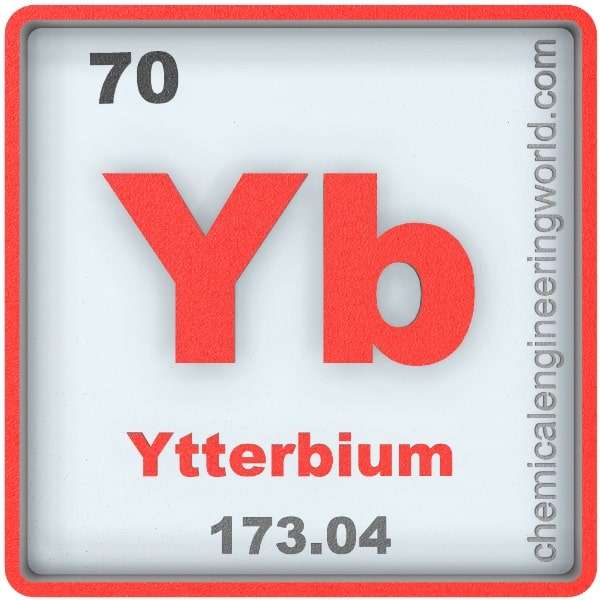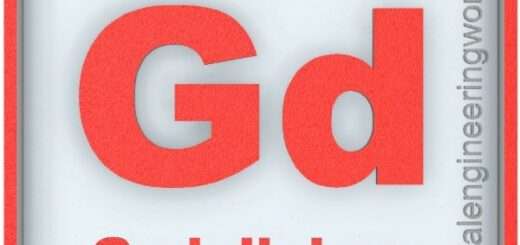Ytterbium Element Properties and Information

Ytterbium Element Properties and Information
Ytterbium is 70th element on the periodic table. Elements are arranged in the periodic table on the basis of the atomic number. Atomic number is the number of protons in the nucleus of the atom. Ytterbium has an atomic number of 70. It is located in the Group ‘Lanthanides’ and Period 6 of the periodic table of elements. It is denoted by ‘Yb’. It is named after Ytterby, Sweden.
Ytterbium was also discovered in same manner as other elements in lanthanide series were discovered. It all started with discovery of Yttrium in 1794 which was later found to be contaminated from which many new elements were separated. Erbium was separated from yttrium in 1843. In 1878, Jean Charles Galissard de Marignac heated erbium nitrate until it decomposed and extracted two oxides; a red one a white one. The red oxide was erbium and the white oxide belonged to a new element, Ytterbium.
Like all other lanthanides, ytterbium is principally extracted from monazite. The concentration of ytterbium is 300 ppm in the monazite ores. Ytterbium follows Oddo-Harkins rule as an even numbered element.
Physical Properties
- Ytterbium is a soft, ductile, and malleable element which shines with bright silvery lustre. Also, it is the penultimate element in the lanthanide series.
- The atomic mass of ytterbium is 173.04.
- The melting point of ytterbium is 824°C.
- The boiling point of ytterbium is 1466°C.
- The density of ytterbium is 7000 in S.I. units at 20°C.
- Yttrium has three allotropes and its transformation temperatures are around -13°C and 795°C. The exact transformation temperature depends on pressure and stress.
- Ytterbium shows a paramagnetic ordering.
Naturally occurring ytterbium is composed of 7 stable isotopes; ytterbium-168, ytterbium-170, ytterbium-171, ytterbium-172, ytterbium-173, ytterbium-174, and ytterbium-176.
Chemical Properties
- Ytterbium tarnishes slowly in air, which is observed by appearance of golden-brown hue.
- Ytterbium readily oxidizes in air.
- Ytterbium reacts with hydrogen to form variety of non-stoichiometric hydride compound.
- Ytterbium reacts with water; slowly with cold-water and faster with hot-water to form ytterbium(III) oxide.
- Ytterbium reacts and dissolves quickly in acids.
- Ytterbium reacts with all halogens to form the corresponding trihalides.
Methods of Production
Ion Exchange: The monazite mineral is crushed and dissolved into sulphuric acid. The sulphates of the lanthanides are then converted to oxalates then to oxides then to double-salts. Ion-exchange method is used to separate ytterbium from other lanthanides. The solution is first applied to a resin at which different lanthanides bind to a different matter. The solution is then dissolved in a complexing agent wherein the lanthanide of interest is isolated from others by exploiting different bonding properties.
Relevance in Chemical and Related Industries
Stainless Steel: Doping of ytterbium in stainless-steel improves its strength, grain-refinement, and other mechanical properties.
Relevance in Other Industries
- Radiography: The ytterbium-169 isotope is used as a gamma ray source in portable X-ray machines; it finds its use in radiography.
- Atomic Clocks: Ytterbium based atomic-clocks are one of the best because they hold record for stability with ticks. The stability is within 2 parts per quintillion.
- Lasers: Ytterbium lasers can generate short-pulses, and are quite durable and efficient. They especially find applications in double-clad fibres and solid-state lasers.
Health Effects on Exposure
- Irritant: Ytterbium is a skin and eye irritant.
- Teratogen: Ytterbium causes malformation in embryo.
- Toxicity: Ytterbium and its compounds are highly toxic in nature.
Effects on Surroundings
Ytterbium poses no harm to plants, animals, and environment.
References:
https://en.wikipedia.org/wiki/Ytterbium
https://www.lenntech.com/periodic/elements/yb.htm
































